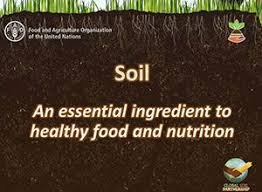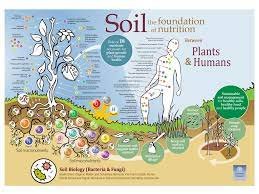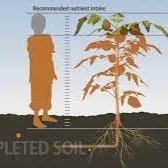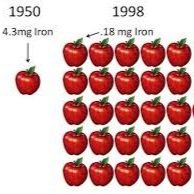Nutritious food starts with fertile soil
The world is changing and some people lose hope. I do not! In fact I see a lot of positive changes happening in the world of gardening, growing and food production. Some of these changes are not “in the news” and do not appear in statistics yet, but are significant and will have a long term effect. Gardening and growing some of your own food reduces your carbon foot print. According to a 2017 study by Bord Bia, there are approximately 1.3 million regular gardeners in Ireland. (Just imagine we had a United Garden Party!) About 300 000 grow regularly vegetables at home and more than 900 000 sow or plant herbs in their garden. And although we don't feature in the big debate about reducing emissions, our gardens have potential to store huge amounts of carbon, as well as mitigate some of the effects of climate change such as flooding risk, urban heat island effect and loss of biodiversity. The more we garden and keep soil fertile the healthier the planet will be – we all do make a difference.
Hundreds and thousands of gardeners and growers are very aware of the benefits of growing food for the family. Many are new to growing and the hunger for knowledge and know-how is huge. Here are my thoughts to help making this awareness permanent for the benefit of all gardeners and ultimately for our planet.
“There is nothing in the whole of nature which is more important than or deserves as much attention as the soil. Truly it is the soil which makes the world a friendly environment for mankind. It is the soil which nourishes and provides for the whole of nature; the whole of creation depends upon the soil which is the ultimate foundation of our existence.” (Friedrich Albert Fallou, 1862)
Huge advantages of growing your own food
If we grow our own food in our own garden we have the huge advantage to grow the most nutritious, the most nutrient dense food. There are no food miles, we do not need artificial chemical fertilisers, we do not need weed killer and pesticides, all we need is the best soil we can get and if our soil is poor for starters we can remedy that in one season with compost and/or manure. By growing food from seeds we can also use varieties best suited to our local conditions and microclimate and even better save seeds.
“Cultivating soil and encouraging plants to grow in harmony with nature’s wondrous system has been an honored avocation throughout history”, writes Bill Wolf in his foreword to ‘The Soul of Soil’ in 1999. This avocation has now become the main occupation for many farmers, growers and gardeners, because cultivating soil and keeping soil fertile to grow nutritious food single handedly is the best contribution anybody can make to combat climate change and its consequences.
To understand soil is to be aware of how everything affects and is affected by it. We are all part of the soil ecosystem. Soil is not just dirt or the loose surface that covers most land. Soil provides the structure for plants to grow and anchor, it is also their source for water and nutrients. Soil contains minerals, organic matter and a rich biodiversity.
The microcosm under our feet
Garden soil resembles a city organised down to the smallest detail, a city in which millions of inhabitants are at work day and night. The teamwork takes place in three well organised zones. The uppermost layer in a garden consists of a mulch cover, then comes the decomposition zone, about 5 cm deep, where earthworms, millipeds, woodlice and other specialized microorganisms start the decomposition process, next comes the humus layer 20-30cm deep, where different microorganisms , bacteria, algae and fungi construct building blocks of life from the ingredients of the decomposition layer and create food for the root systems of the plants.
Soil is the foundation of nutrition
“ We really should be orienting agriculture toward ensuring that nutrient levels are as high and as balanced as they can be in plants (…), because that ultimately has an effect on human health”. (Anne Bikle and David R. Montgomery, The Hidden Half of Nature).
The soil doesn’t only supply the major macronutrients like nitrogen (N), phosphorus (P), potassium (K), in big quantities, but also calcium, magnesium, and sulphur. And in relatively small amounts, the soil supplies iron, manganese, boron, molybdenum, copper, zinc, chlorine, and cobalt, the so-called micronutrients. Therefore, soils that provide a healthy, nutrient-rich growth medium for plants will result in plant tissues that contain most of the elements required for human life when the plants are consumed.
The Food and Agriculture Organization of the United Nations has published a fascinating fact sheet on “Soil – the foundation of nutrition” featuring the role of 18 nutrients necessary for plant growth and human health. Zinc (Zn) for example is needed by plants for seed quality and growth, humans need it for a functioning reproductive system and to promote immune system health. Plants need Calcium (Ca) for photosynthesis, growth and fruit formation, humans need Calcium for healthy bones, the digestive process and muscle and nerve activity.
Soil degradation leads to micronutrient deficiencies
The fact sheet (published 2015 during the International Year of the Soil) also states that over two billion people suffer from micronutrient deficiencies, because of soil degradation. The Organic Consumers Association cites several studies with similar findings: A Kushi Institute analysis of nutrient data from 1975 to 1997 found that average calcium levels in 12 fresh vegetables dropped 27 percent; iron levels 37 percent; vitamin A levels 21 percent, and vitamin C levels 30 percent. A similar study of British nutrient data from 1930 to 1980, published in the British Food Journal, found that in 20 vegetables the average calcium content had declined 19 percent; iron 22 percent; and potassium 14 percent.
“Mineral deficiency is estimated to afflict more than a third of humanity, causing health problems in both developed and developing countries,” says David R. Montgomery says. “Mineral elements are essential for hundreds of critical enzyme reactions, and inadequate levels have been implicated in a wide range of maladies.”
Regenerative Farming can help create healthy soil
Because intensive agriculture and production has put a strain on our soils, we need a shift towards practices that bring life back to our soils. And there are solutions everywhere, like regenerative farming, which is take up by a whole generation of young Irish farmers and growers. Bord Bia explains that this agricultural system “puts more back into the environment and society than it takes out. By naturally reintroducing carbon and nutrient resources back into the land, this approach can support ecosystem health, mitigate climate change, and support farmers and their livelihoods through more reliable growing yields.”
Recent study showed that food grown on regenerative farms contained on average more magnesium, calcium, potassium and zinc and more vitamins (including B1, B 12, C, e and K) than food produced on conventional farms.
We can all compost
So back to our gardens and polytunnels and how we can regenerate and keep our soil fertile and alive. The answer is simple: Recycling nutrients by composting! Compost, like humus is made of decomposed organic material. Humus is created through the natural decay of plant materials in the soil’s top layer. Composting is recycling material by people from leftover plant and food waste and other natural waste materials. My anecdotal research through social media shows that gardeners are as enthusiastic and resourceful when it comes to home composting as they are in using polytunnels of all sizes to produce healthy and tasty food.





